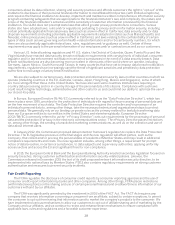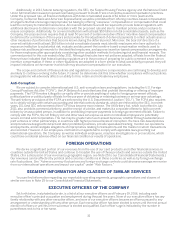American Express 2015 Annual Report Download - page 36
Download and view the complete annual report
Please find page 36 of the 2015 American Express annual report below. You can navigate through the pages in the report by either clicking on the pages listed below, or by using the keyword search tool below to find specific information within the annual report.
In December 2015, the Basel Committee proposed a series of revisions to the standardized approach to
calculating regulatory capital requirements, including new rules that would require holding additional capital for certain
“unconditionally cancellable commitments” such as unused credit card lines of credit. If adopted in the United States
as proposed by the Basel Committee, the changes would require credit card issuers like us to hold significantly more
capital. Federal banking regulators have previously acknowledged the proposal and indicated that the revisions would
apply primarily to large, internationally active banking organizations. This could include all advanced approaches
institutions, such as the Company. In addition, the Basel Committee has proposed adjustments to the standardized
calculation of operational risk capital requirements. If adopted in the United States as proposed by the Basel
Committee, the changes would require banking organizations that are highly specialized in fee-based businesses and
conduct significant fee-based activities like us to hold significantly more capital.
Leverage Requirements
Banking organizations are also required to comply with minimum leverage ratio requirements. The leverage ratio
is the ratio of a banking organization’s Tier 1 capital to its total adjusted average assets (as defined for regulatory
purposes). All banking organizations are required to maintain a leverage ratio of at least 4.0 percent.
The New Capital Rules also establish a supplementary leverage ratio requirement for advanced approaches
banking organizations such as the Company, consistent with the Basel III framework. The supplementary leverage
ratio is the ratio of Tier 1 capital to an expanded concept of leverage exposure that includes both on-balance sheet and
certain off-balance sheet exposures. The New Capital Rules require a minimum supplemental leverage ratio of 3.0
percent for advanced approaches banking organizations as reported to the federal banking regulators, with full
implementation and compliance by January 1, 2018.
Liquidity Regulation
Liquidity risk management and supervision have become increasingly important since the financial crisis. The
Federal Reserve’s heightened prudential requirements rule, which applies to the Company and is discussed in
“Heightened Prudential Requirements for Large Bank Holding Companies,” includes enhanced liquidity and overall risk
management requirements. The Federal Reserve’s rule focuses on a bank holding company’s process to manage
liquidity risk and details certain requirements and responsibilities for boards of directors and senior management
relating to liquidity planning and overall risk management. The rule also requires the maintenance of a liquidity buffer,
consisting of highly liquid assets, that is sufficient to meet projected funding needs for 30 days over a range of liquidity
stress scenarios.
In addition, the Company has been subject to the liquidity coverage ratio (“LCR”) requirement since January 2015,
which is designed to ensure that the banking entity maintains an adequate level of unencumbered high-quality liquid
assets that can be converted into cash to meet its liquidity needs for a 30-day time horizon under an acute liquidity
stress scenario specified by supervisors. The ratio of a firm’s high-quality liquid assets to its projected net outflows is
its LCR. The most comprehensive form of the LCR requirement applies only to advanced approaches banking
organizations, such as the Company, and their depository institution subsidiaries with $10 billion or more in total
consolidated assets, such as Centurion Bank and American Express Bank. Under the federal banking regulators’ LCR
rule, covered banking organizations are required to comply with the LCR on an accelerated schedule, maintaining a
minimum ratio of 80 percent beginning January 1, 2015, 90 percent by January 1, 2016 and 100 percent by January 1,
2017. The Company is required to calculate the LCR on a monthly basis, and on a daily basis starting July 1, 2016. As of
December 31, 2015, the Company, Centurion Bank and American Express Bank were in compliance with the
requirements of the LCR rule. The LCR is one of the two new standards provided for in the Basel III liquidity framework.
The Basel III framework also includes a second standard, referred to as the net stable funding ratio (“NSFR”),
which is designed to promote more medium- and long-term funding of the assets and activities of banking entities over
a one-year time horizon. These requirements will incent banking entities to increase their holdings of cash, U.S.
Treasury securities and other sovereign debt as a component of assets and increase the use of long-term debt as a
funding source. On October 31, 2014, the Basel Committee published the final NSFR, which contemplates that the
NSFR will be implemented as a minimum standard by January 1, 2018. The Basel Committee’s final NSFR document
states that the NSFR applies to internationally active banks. Federal banking regulators have not yet proposed rules
implementing the NSFR liquidity framework for U.S. banking institutions, so the ultimate requirements to which we
may be subject are not yet known.
Prompt Corrective Action
The FDIA requires, among other things, that federal banking regulators take prompt corrective action in respect of
FDIC-insured depository institutions (such as Centurion Bank and American Express Bank) that do not meet minimum
capital requirements. The FDIA specifies five capital tiers: “well capitalized,” “adequately capitalized,”
“undercapitalized,” “significantly undercapitalized” and “critically undercapitalized.” Once an institution becomes
“undercapitalized,” the FDIA imposes progressively more restrictive constraints on operations, management and
capital distributions, depending on the capital category in which an institution is classified.
25
























